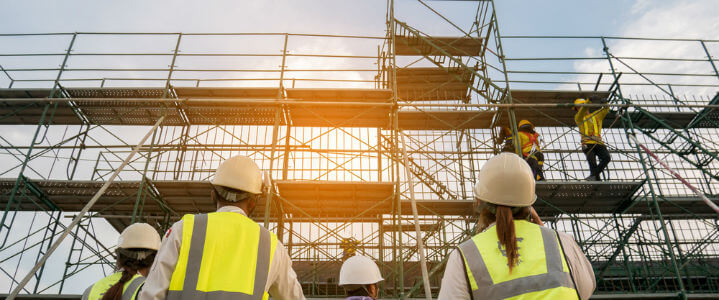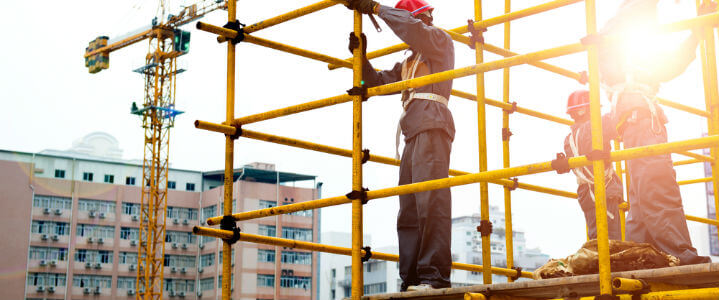Construction workers often work at heights and face a variety of risks. To ensure their safety, OSHA has established specific scaffolding requirements. These rules are designed to protect workers from falls, injuries, and other hazardous conditions while working on scaffolds. After all, improper scaffolding is the #3 most cited OSHA violation. This article will discuss the OSHA requirements for scaffolding in construction sites and how they can help keep workers safe.
Below, you’ll find 12 scaffolding safety rules and some other helpful information.
12 OSHA Scaffolding Standards & Safety Requirements
Every year, around 4,500 workers suffer scaffolding injuries. Approximately 50 of those workers die as a result. For your convenience, we have provided you with an outline of the OSHA scaffolding requirements below. As always, refer to the official OSHA documentation for more details and information.

1. Weight Capacity
How much weight must a scaffold be capable of supporting?
Your scaffold must be structurally sound and sturdy enough to support its weight plus four times the max intended load. It should do all of this without settling or any displacement whatsoever. Scaffolds should be set up on completely solid footing. Following these fall protection safety tips can help keep your workers safe and your business compliant.
2. Stability
Unsteady objects, such as loose bricks, boxes, barrels, etc., should never be used to support planks or scaffolds.
3. Supervised Setup
A competent person must supervise workers as scaffolds are erected, dismantled, moved, or altered in any way.
4. Extra Precaution
All scaffolding must be equipped with toeboards, midrails, and guardrails. Wondering about scaffold guardrail height requirements? Here are the scaffold guardrail requirements.
The toprails manufactured and in service after January 1, 2000, must be between 38 and 45 inches tall. For toprails manufactured and in service before January 1, 2000, the height must be between 36 and 45 inches.
5. Maintenance
Brackets, braces, screw legs, trusses, or ladders should be routinely examined. Any weak or damaged equipment should be replaced or repaired immediately.
6. Materials
Your scaffolding platforms should be tightly planked. Ensure the scaffold plank grade material or equivalent is used.
7. Scaffolding Inspection
The designated and certified “competent person” is required to inspect all scaffolding. The competent person must re-inspect at predetermined intervals. Even the slightest alterations/shifts could pose a potential danger to workers.
8. Rigging Inspection
The rigging on all suspension scaffolds must undergo inspection by your site’s competent person. This should occur before each shift. And this inspection should be performed again. Sometimes the structural integrity of suspension scaffolding is not safe. It has been affected or compromised. Connections should be tight. Absolutely no damage should occur within the rigging.
9. Rigging Protection
Natural or synthetic rope involved in the suspension scaffold setup should be monitored. It needs to be protected from nearby heat-producing machinery and other sources.
10. Diagonal Braces Instruction
Your employees must be trained about the hazards of using diagonal braces as their fall protection.
11. Access
Your scaffolding may be accessed by way of stairwells and ladders. Do not access via unsteady objects.
12. Power Line Distance
Your scaffolding must always rest at least 10 feet away from electrical power lines.

Feeling overwhelmed? A safety consulting firm like Safety by Design can save you time and energy. Our training will equip you and your employees with scaffolding safety and so much more.
How High Can You Build a Scaffold Without a License?
The OSHA scaffolding safety procedures guide says it like this. Employers must provide fall protection for every employee on scaffolding more than 10 feet above a lower level. A competent person should determine the fall protection for employees working on supported scaffolds.
Learn more about our OSHA Scaffold Competent Person Training today!
Construction scaffolding safety is paramount. OSHA states that scaffolds more than 125 feet in height above the base must be designed by a registered professional engineer. These scaffold height restrictions reflect the hazards and structural stress when working at such heights.
In addition, scaffolding harness regulations should be determined by your competent person. Personal fall arrest systems involve the harnesses themselves, but they also involve the components of these belts like Dee-rings, lifelines, snap hooks, and the anchorage point.
Finding the Best OSHA Scaffold Training Company Near You
Interested in OSHA scaffold training for your competent person? We can help you comply with all the OSHA and ANSI scaffold standards. Use Safety by Design’s safety training in Houston to ensure a secure workplace.
Have questions concerning scaffolding laws, regulations, and everything in between? We’ll go above and beyond to answer them and make your company safer! Whatever your workplace training needs, contact the Safety by Design team today.
Tags: OSHA standards, safety training, working at heights


